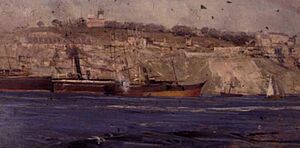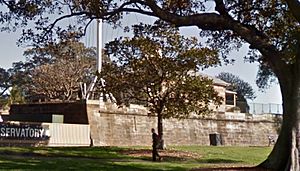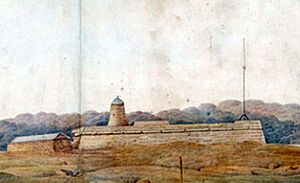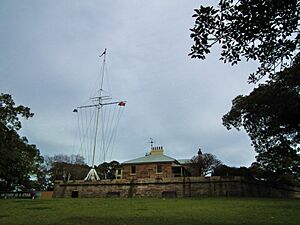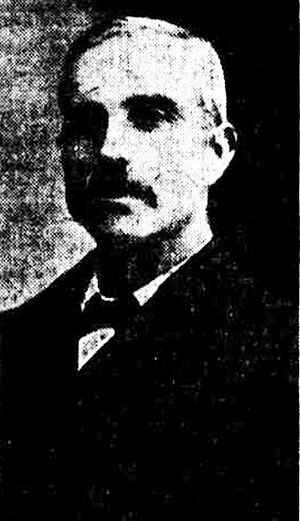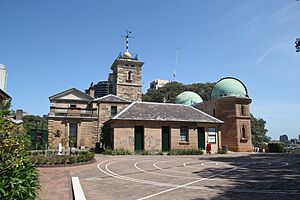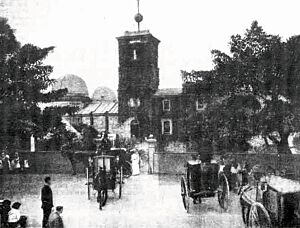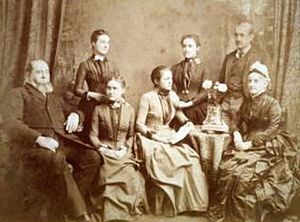Observatory Park, Sydney facts for kids
Quick facts for kids Observatory Park |
|
|---|---|
| Observatory Hill; Sydney Observatory | |
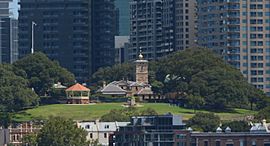
Observatory Park, Sydney
|
|
| Lua error in Module:Location_map at line 420: attempt to index field 'wikibase' (a nil value). | |
| Location | Kent Street, Watson Road, Upper Fort Street and Bradfield Highway, Millers Point |
| Nearest city | Sydney, New South Wales, Australia |
| Owned by | City of Sydney and National Trust of Australia |
| Open | 24 hours |
| Status | Open all year |
| Public transit access | Sydney Trains:
|
| Facilities | Rotunda, ample grassed area with views across Sydney Harbour Bridge, outdoor gymnasium, Sydney Observatory, the Signal Station, the remains of Fort Philip |
Observatory Park is a cool park right in the middle of Sydney, Australia. It's super close to the famous Sydney Harbour Bridge. This park has a long history, going all the way back to 1796! Back then, it was called Windmill Hill because it had the very first windmill in the colony.
Today, it's also known as Observatory Hill because of the historic Sydney Observatory located there. You can also find other old buildings like the Signal Station, parts of Fort Philip, the National Trust Centre, and a pretty rotunda where people sometimes have weddings.
Contents
Discovering Observatory Hill's Past
Observatory Park has a fascinating past. It started with a windmill built by a convict named John Davis in 1796. This stone tower helped grind wheat for the early colony. After that windmill broke down, another one was built nearby, giving the area its "Windmill Hill" name.
Fort Philip: Sydney's Old Defense Post
In 1804, a fort called Fort Philip was built on the hill. It had cannons and a place to store gunpowder. The fort was partly taken down in the 1850s, but you can still see some of its old walls today. These walls were later used as the base for the Signal Station.
The remains of Fort Philip are still visible on Observatory Hill. You can see them as walls near the Signal Station. These are the eastern parts of the fort, which became the foundation for the Signal Station in 1848. The chains on the wall were used to stop the cannons from recoiling too much when fired.
Governor King started building Fort Philip in 1804, but it was never fully finished. It was built around the first windmill, which you can see in old paintings. The fort was meant to be hexagonal, but only three sides were mostly completed. Construction stopped in 1806.
The fort was originally planned to help defend against a possible uprising by Irish settlers. However, no such event happened, and the area was later used for other things. In 1815, a powder magazine was built next to the fort, but it also wasn't fully completed.
The Signal Station: Sending Messages by Flag
In 1847, a signal station was built on the hill. For many years, it was called the Fort Philip Signal Station. This building is now open to the public. Before the stone building, a flagstaff was put up in 1808, and a semaphore (a device with moving arms to send messages) was added by 1823.
The semaphore used two swinging arms that could be moved into different positions. These positions spelled out numbers, which could be turned into letters using a special code book. The first signalman's hut was very small. It was replaced in 1847 by the larger stone building you see today, designed by architect Mortimer Lewis. This building was home to the signal masters and their families until the station closed in 1939.
In 1912, a newspaper interviewed Jeremiah McCarthy, who was the signal master. He explained how flags were used to share information. He said that two small rooms were enough for the work. One was for telegraphs and phones, and the other stored many brightly colored flags.
Signals were made in "hoists." When a ship was spotted, the flag of its company went up. A square flag showed if it was a steamer or a sailing ship, and two triangular flags showed its last port. For example, a P. and O. liner would have its company flag, a blue and yellow chessboard flag for a steamer, and two colored triangles for its last port.
Jeremiah McCarthy was the signal master from 1902 until he passed away in 1920. He had worked in the navy and as a lighthouse keeper before this job.
Sydney Observatory: Watching the Stars and Keeping Time
Sydney Observatory was built between 1857 and 1859. It was designed by Alexander Dawson, the Colonial Architect. The building mixes two styles: Italian High Renaissance Palazzo and Italian Villa. A west wing was added in 1876.
The observatory was placed on the hill so it could be easily seen from the harbor. Its first job was to provide a time service using the Time Ball, which still works today! The Time Ball would drop at 1 p.m. At the same moment, a cannon would fire at Dawes Point (and later at Fort Denison). This helped ships reset their clocks (called chronometers) after being at sea for a long time.
The Powerhouse Museum explains how the Time Ball works: It has a heavy cast iron cylinder, piston, and a lifting system. The ball is raised almost 3 meters to the top of a mast. About six minutes before 1 p.m., the ball starts to go up. It takes almost three minutes to reach the top. At exactly 1 p.m., a signal from an atomic clock releases a safety lock, and the Time Ball drops. It falls quickly at first, then slows down as air pressure in the cylinder acts as a cushion.
The longest-serving Government Astronomer at the Observatory was Henry Chamberlain Russell. He worked there from 1870 until he passed away in 1907. Russell made big changes to the observatory, focusing on studying star positions, double stars, and star clusters. He also had strong ties with the University of Sydney.
The Rotunda: A Place for Music and Weddings
The Rotunda was built in 1912. Back then, bands like the Metropolitan Band often played music there, especially on Sunday afternoons and evenings. They played classical music and songs from Gilbert and Sullivan. The City of Sydney Band also performed often in the park.
Today, the Rotunda is a popular spot for weddings. It offers beautiful views of Sydney Harbour and is surrounded by lovely parkland.
Boer War Memorial: Remembering History
The Boer War Memorial was built in 1940. The stones used to build it are very old, over 200 years! They came from a building at Circular Quay that was built during the time of Governor Macquarie.
Major General Sir Charles Cox, who was 77 years old at the time, unveiled the memorial. He was a young officer during the Boer War in 1899, leading the New South Wales Mounted Rifles. His name is on the memorial.
The gun next to the memorial was captured from the Boers by the British during the war. It was given to the Australian Government in 1905. This 75mm gun was first in the Botanic Gardens. However, veterans of the war asked for it to be moved to their memorial, and so it was.


